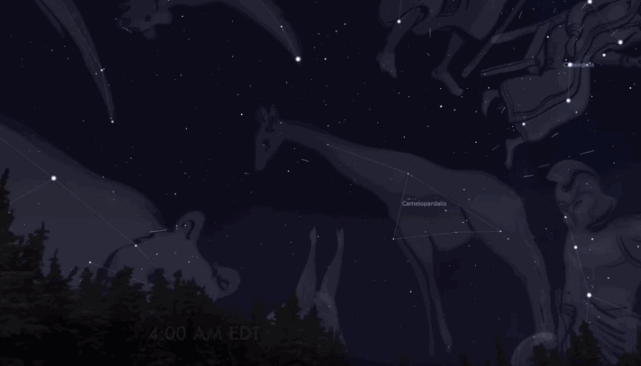See the mysterious October Camelopardalid meteor shower peak tonight (Oct. 6)
The October Camelopardalids aren't particularly bright, but they're a curiosity worth trying to see.

The October Camelopardalid meteor shower peaks on Thursday evening (Oct. 6), offering a chance to catch a few early autumn meteors before the much more brilliant Taurids peak next month.
The radiant of the October Camelopardalids — the point from which they appear to originate — will be just below the actual Camelopardalis, or giraffe, constellation and will appear above the constellations Ursa Minor and Draco.
The radiant will reach its highest point in the sky around 11:00 a.m. EDT (1500 GMT) on Friday (Oct. 7), so the best time for most folks to catch a glimpse of the October Camelopardalids will be between 1:00 a.m. EDT (0500 GMT) and dawn. Skywatchers in New York City should have an optimal view for catching the shower, as Earth will be rotated so that the city faces towards its radiant, according to In-The-Sky.org.
Related: How scientists chased a new meteor shower from the sky
The meteor shower itself is not particularly bright, and unfortunately, the moon will be only three days away from the October full moon, meaning the conditions are not ideal for spotting the Camelopardalids. Still, the meteor shower itself is enough of a curiosity to make it worth attempting to see.
Meteor showers are typically produced by streams of comet debris that burn up in Earth's atmosphere. These debris trails typically distribute themselves along the orbit of their parent objects through our solar system.

Looking for a telescope to observe meteor showers like the Camelopardalids? We recommend the Celestron Astro Fi 102as the top pick in our best beginner's telescope guide.
The October Camelopardalids are somewhat mysterious in that astronomers aren't quite sure what their origin is. The meteors have an orbit, meaning they likely come from a comet with a long period similar to Halley's comet, yet there is no known comet that has been identified as having spawned the Camelopardalids. This means either we haven't discovered it yet, or that the comet has long since disintegrated or crashed into another celestial body similar to Comet Shoemaker-Levy 9, which spectacularly crashed into Jupiter in 1994.
Get the Space.com Newsletter
Breaking space news, the latest updates on rocket launches, skywatching events and more!
Looking for a telescope or binoculars to observe meteor showers and don't know where to start? Our guides for the best binoculars deals and the best telescope deals now can help.
If you're interested in taking your skywatching photography to the next level, make sure not to miss our best cameras for astrophotography and best lenses for astrophotography guides.
Follow Brett on Twitter at @bretttingley. Follow us on Twitter @Spacedotcom or on Facebook.
Join our Space Forums to keep talking space on the latest missions, night sky and more! And if you have a news tip, correction or comment, let us know at: community@space.com.

Brett is curious about emerging aerospace technologies, alternative launch concepts, military space developments and uncrewed aircraft systems. Brett's work has appeared on Scientific American, The War Zone, Popular Science, the History Channel, Science Discovery and more. Brett has English degrees from Clemson University and the University of North Carolina at Charlotte. In his free time, Brett enjoys skywatching throughout the dark skies of the Appalachian mountains.










